HI6008 Semester 1/2018: Managing Cross-Cultural Behavior Challenges
VerifiedAdded on 2023/06/11
|15
|3374
|71
Project
AI Summary
This project report investigates the challenges multinational companies face in managing cross-cultural behavior in international business, focusing on the importance of cross-cultural management and the issues arising from cultural differences. It includes a literature review summarizing key concepts and theories, such as Hofstede's cultural dimensions, and uses the example of Wal-Mart's experience in Germany to illustrate the impact of cultural misunderstandings. The report formulates primary and secondary research questions to explore these challenges, proposes a mixed-methods research design incorporating both qualitative (interviews) and quantitative (questionnaires) approaches, and addresses potential research limitations. The research plan outlines a timeline for various activities, including objective identification, data collection, analysis, and conclusion development, aiming to provide insights into managing cross-cultural dynamics effectively within multinational organizations.

Paraphrase This Document
Need a fresh take? Get an instant paraphrase of this document with our AI Paraphraser
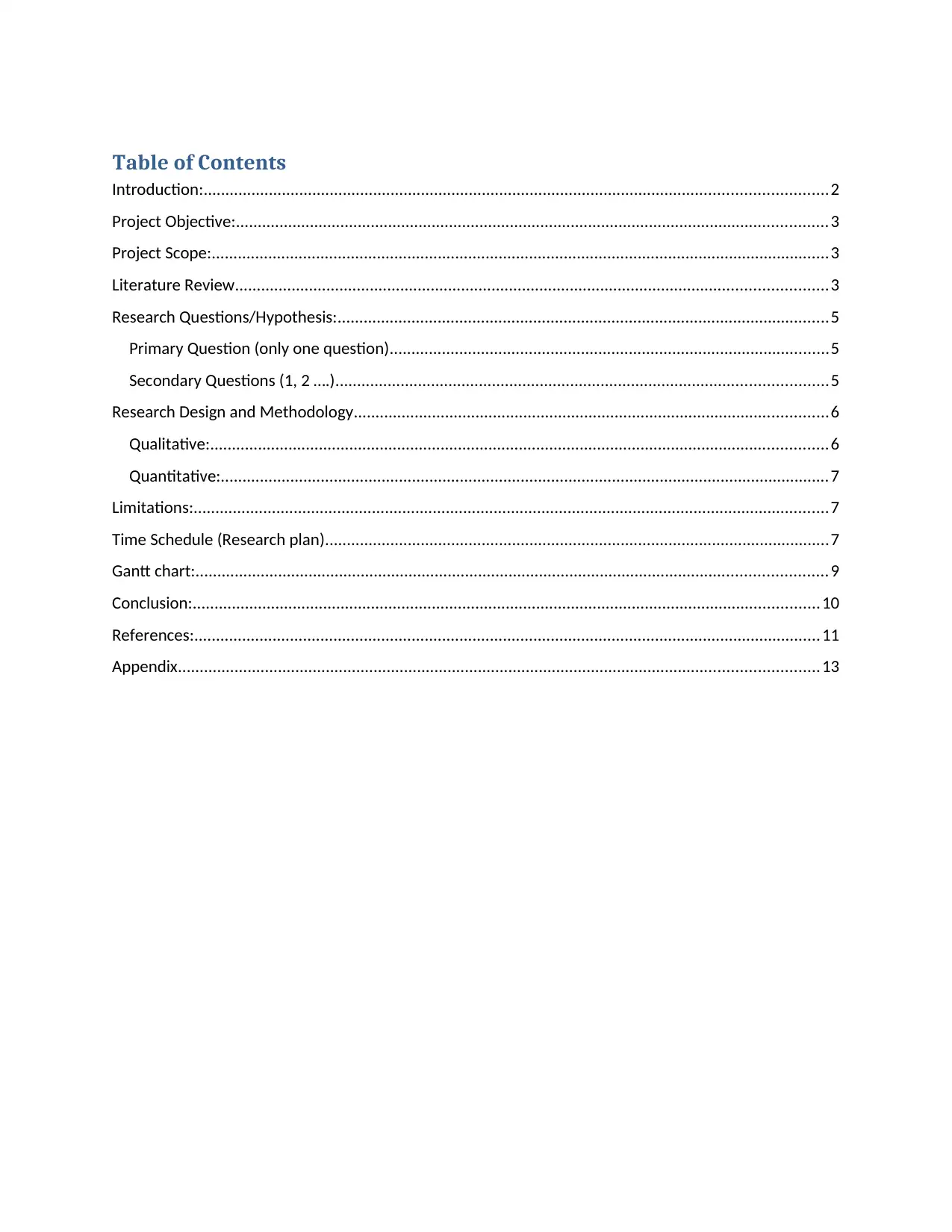
Table of Contents
Introduction:...............................................................................................................................................2
Project Objective:........................................................................................................................................3
Project Scope:..............................................................................................................................................3
Literature Review........................................................................................................................................3
Research Questions/Hypothesis:.................................................................................................................5
Primary Question (only one question).....................................................................................................5
Secondary Questions (1, 2 ….).................................................................................................................5
Research Design and Methodology.............................................................................................................6
Qualitative:..............................................................................................................................................6
Quantitative:............................................................................................................................................7
Limitations:..................................................................................................................................................7
Time Schedule (Research plan)....................................................................................................................7
Gantt chart:.................................................................................................................................................9
Conclusion:................................................................................................................................................10
References:................................................................................................................................................11
Appendix...................................................................................................................................................13
Introduction:...............................................................................................................................................2
Project Objective:........................................................................................................................................3
Project Scope:..............................................................................................................................................3
Literature Review........................................................................................................................................3
Research Questions/Hypothesis:.................................................................................................................5
Primary Question (only one question).....................................................................................................5
Secondary Questions (1, 2 ….).................................................................................................................5
Research Design and Methodology.............................................................................................................6
Qualitative:..............................................................................................................................................6
Quantitative:............................................................................................................................................7
Limitations:..................................................................................................................................................7
Time Schedule (Research plan)....................................................................................................................7
Gantt chart:.................................................................................................................................................9
Conclusion:................................................................................................................................................10
References:................................................................................................................................................11
Appendix...................................................................................................................................................13
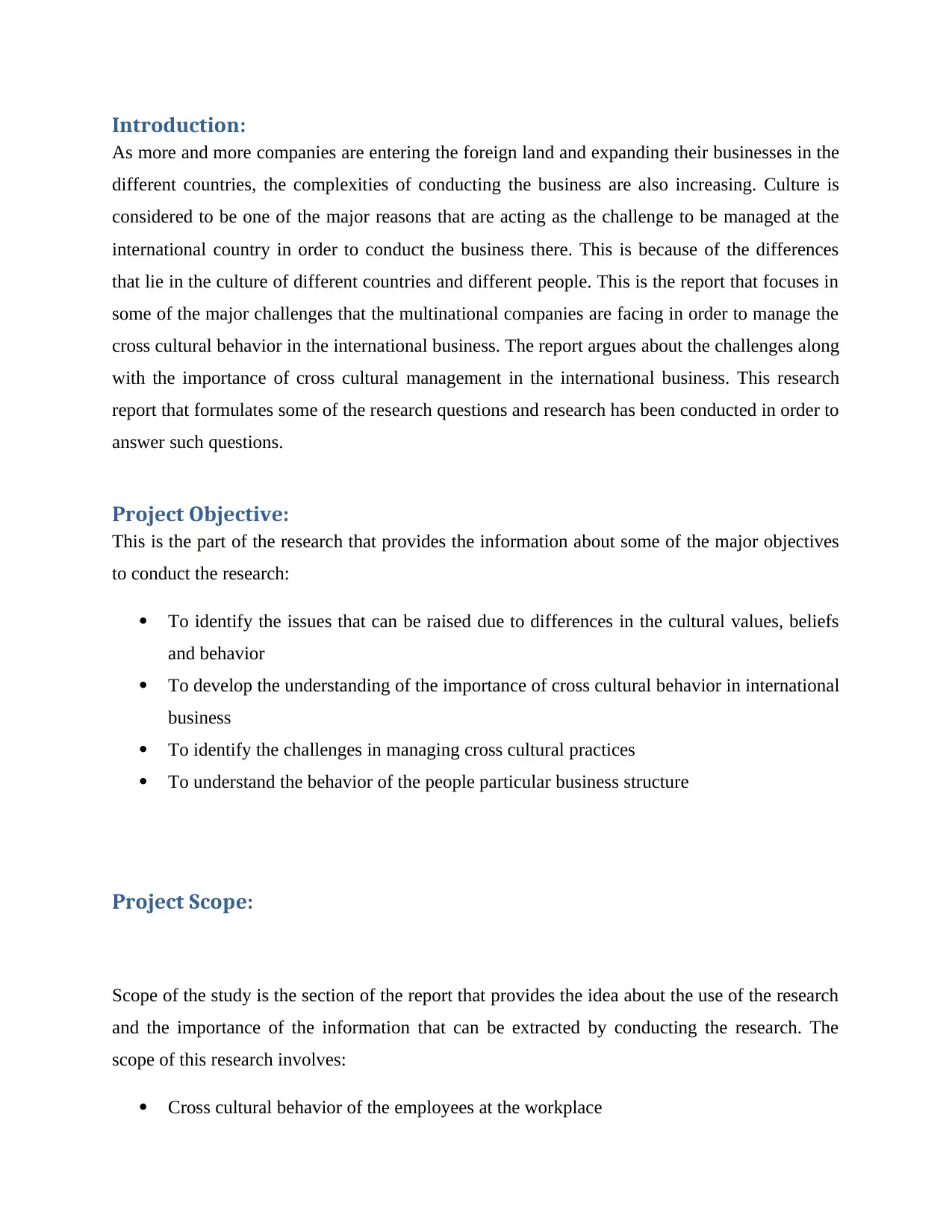
Introduction:
As more and more companies are entering the foreign land and expanding their businesses in the
different countries, the complexities of conducting the business are also increasing. Culture is
considered to be one of the major reasons that are acting as the challenge to be managed at the
international country in order to conduct the business there. This is because of the differences
that lie in the culture of different countries and different people. This is the report that focuses in
some of the major challenges that the multinational companies are facing in order to manage the
cross cultural behavior in the international business. The report argues about the challenges along
with the importance of cross cultural management in the international business. This research
report that formulates some of the research questions and research has been conducted in order to
answer such questions.
Project Objective:
This is the part of the research that provides the information about some of the major objectives
to conduct the research:
To identify the issues that can be raised due to differences in the cultural values, beliefs
and behavior
To develop the understanding of the importance of cross cultural behavior in international
business
To identify the challenges in managing cross cultural practices
To understand the behavior of the people particular business structure
Project Scope:
Scope of the study is the section of the report that provides the idea about the use of the research
and the importance of the information that can be extracted by conducting the research. The
scope of this research involves:
Cross cultural behavior of the employees at the workplace
As more and more companies are entering the foreign land and expanding their businesses in the
different countries, the complexities of conducting the business are also increasing. Culture is
considered to be one of the major reasons that are acting as the challenge to be managed at the
international country in order to conduct the business there. This is because of the differences
that lie in the culture of different countries and different people. This is the report that focuses in
some of the major challenges that the multinational companies are facing in order to manage the
cross cultural behavior in the international business. The report argues about the challenges along
with the importance of cross cultural management in the international business. This research
report that formulates some of the research questions and research has been conducted in order to
answer such questions.
Project Objective:
This is the part of the research that provides the information about some of the major objectives
to conduct the research:
To identify the issues that can be raised due to differences in the cultural values, beliefs
and behavior
To develop the understanding of the importance of cross cultural behavior in international
business
To identify the challenges in managing cross cultural practices
To understand the behavior of the people particular business structure
Project Scope:
Scope of the study is the section of the report that provides the idea about the use of the research
and the importance of the information that can be extracted by conducting the research. The
scope of this research involves:
Cross cultural behavior of the employees at the workplace
⊘ This is a preview!⊘
Do you want full access?
Subscribe today to unlock all pages.

Trusted by 1+ million students worldwide
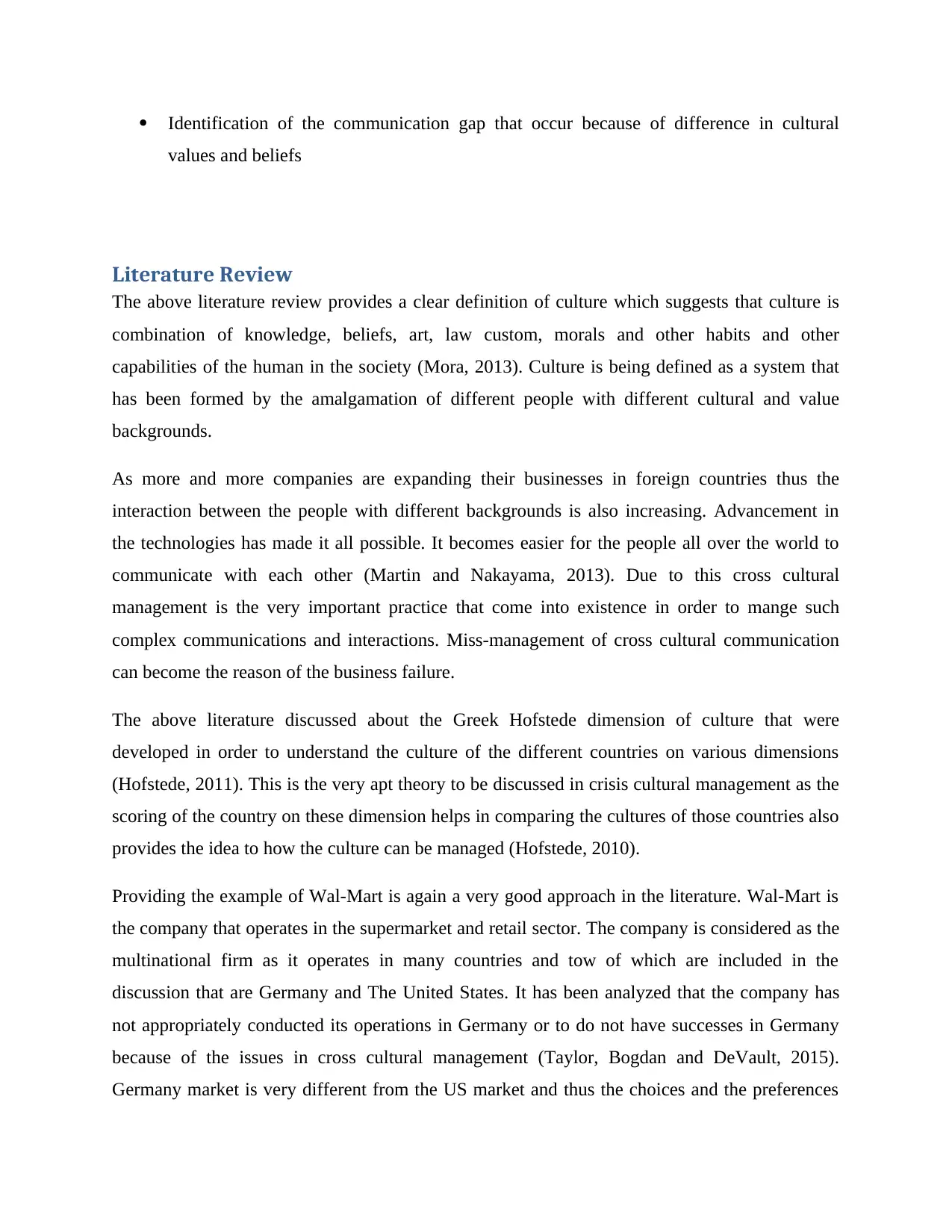
Identification of the communication gap that occur because of difference in cultural
values and beliefs
Literature Review
The above literature review provides a clear definition of culture which suggests that culture is
combination of knowledge, beliefs, art, law custom, morals and other habits and other
capabilities of the human in the society (Mora, 2013). Culture is being defined as a system that
has been formed by the amalgamation of different people with different cultural and value
backgrounds.
As more and more companies are expanding their businesses in foreign countries thus the
interaction between the people with different backgrounds is also increasing. Advancement in
the technologies has made it all possible. It becomes easier for the people all over the world to
communicate with each other (Martin and Nakayama, 2013). Due to this cross cultural
management is the very important practice that come into existence in order to mange such
complex communications and interactions. Miss-management of cross cultural communication
can become the reason of the business failure.
The above literature discussed about the Greek Hofstede dimension of culture that were
developed in order to understand the culture of the different countries on various dimensions
(Hofstede, 2011). This is the very apt theory to be discussed in crisis cultural management as the
scoring of the country on these dimension helps in comparing the cultures of those countries also
provides the idea to how the culture can be managed (Hofstede, 2010).
Providing the example of Wal-Mart is again a very good approach in the literature. Wal-Mart is
the company that operates in the supermarket and retail sector. The company is considered as the
multinational firm as it operates in many countries and tow of which are included in the
discussion that are Germany and The United States. It has been analyzed that the company has
not appropriately conducted its operations in Germany or to do not have successes in Germany
because of the issues in cross cultural management (Taylor, Bogdan and DeVault, 2015).
Germany market is very different from the US market and thus the choices and the preferences
values and beliefs
Literature Review
The above literature review provides a clear definition of culture which suggests that culture is
combination of knowledge, beliefs, art, law custom, morals and other habits and other
capabilities of the human in the society (Mora, 2013). Culture is being defined as a system that
has been formed by the amalgamation of different people with different cultural and value
backgrounds.
As more and more companies are expanding their businesses in foreign countries thus the
interaction between the people with different backgrounds is also increasing. Advancement in
the technologies has made it all possible. It becomes easier for the people all over the world to
communicate with each other (Martin and Nakayama, 2013). Due to this cross cultural
management is the very important practice that come into existence in order to mange such
complex communications and interactions. Miss-management of cross cultural communication
can become the reason of the business failure.
The above literature discussed about the Greek Hofstede dimension of culture that were
developed in order to understand the culture of the different countries on various dimensions
(Hofstede, 2011). This is the very apt theory to be discussed in crisis cultural management as the
scoring of the country on these dimension helps in comparing the cultures of those countries also
provides the idea to how the culture can be managed (Hofstede, 2010).
Providing the example of Wal-Mart is again a very good approach in the literature. Wal-Mart is
the company that operates in the supermarket and retail sector. The company is considered as the
multinational firm as it operates in many countries and tow of which are included in the
discussion that are Germany and The United States. It has been analyzed that the company has
not appropriately conducted its operations in Germany or to do not have successes in Germany
because of the issues in cross cultural management (Taylor, Bogdan and DeVault, 2015).
Germany market is very different from the US market and thus the choices and the preferences
Paraphrase This Document
Need a fresh take? Get an instant paraphrase of this document with our AI Paraphraser
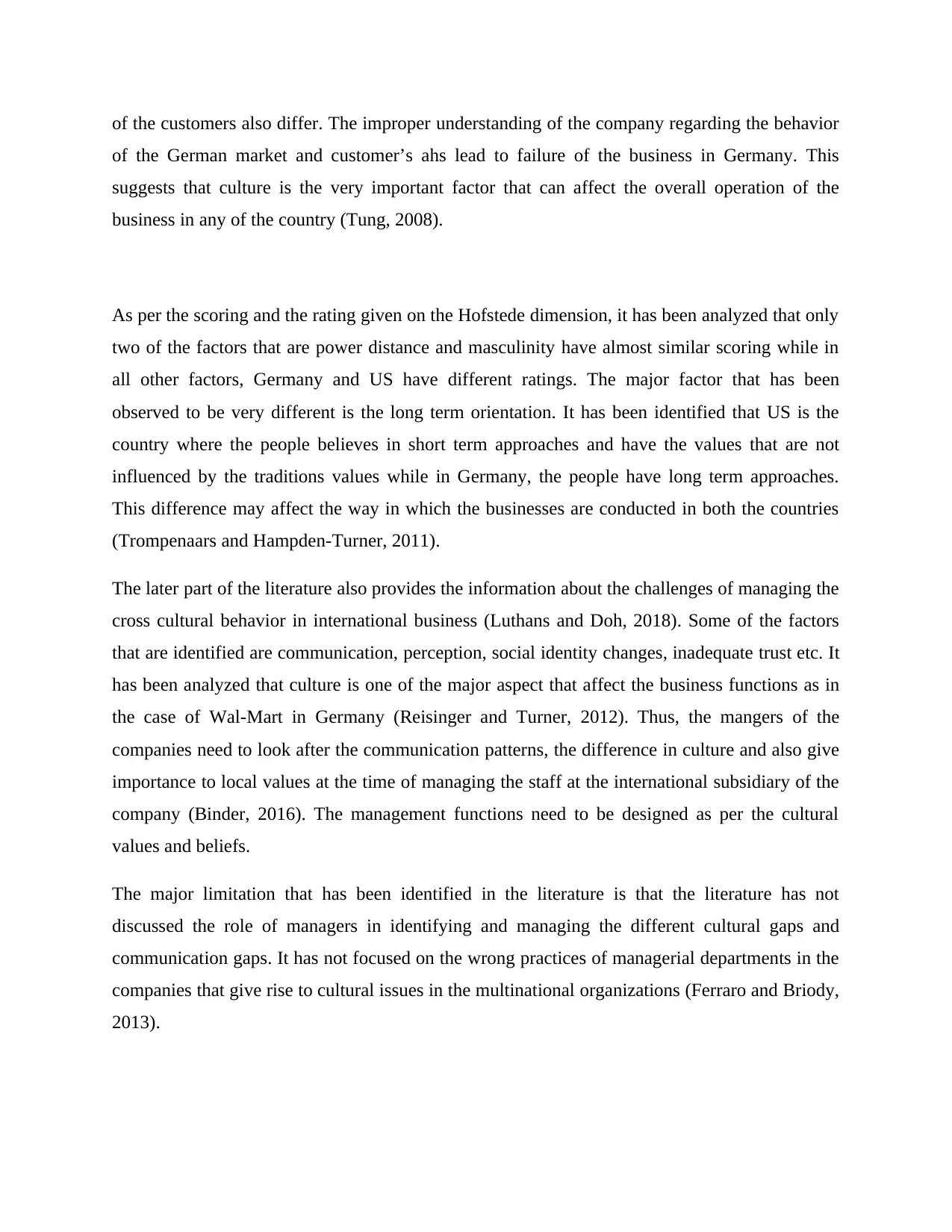
of the customers also differ. The improper understanding of the company regarding the behavior
of the German market and customer’s ahs lead to failure of the business in Germany. This
suggests that culture is the very important factor that can affect the overall operation of the
business in any of the country (Tung, 2008).
As per the scoring and the rating given on the Hofstede dimension, it has been analyzed that only
two of the factors that are power distance and masculinity have almost similar scoring while in
all other factors, Germany and US have different ratings. The major factor that has been
observed to be very different is the long term orientation. It has been identified that US is the
country where the people believes in short term approaches and have the values that are not
influenced by the traditions values while in Germany, the people have long term approaches.
This difference may affect the way in which the businesses are conducted in both the countries
(Trompenaars and Hampden-Turner, 2011).
The later part of the literature also provides the information about the challenges of managing the
cross cultural behavior in international business (Luthans and Doh, 2018). Some of the factors
that are identified are communication, perception, social identity changes, inadequate trust etc. It
has been analyzed that culture is one of the major aspect that affect the business functions as in
the case of Wal-Mart in Germany (Reisinger and Turner, 2012). Thus, the mangers of the
companies need to look after the communication patterns, the difference in culture and also give
importance to local values at the time of managing the staff at the international subsidiary of the
company (Binder, 2016). The management functions need to be designed as per the cultural
values and beliefs.
The major limitation that has been identified in the literature is that the literature has not
discussed the role of managers in identifying and managing the different cultural gaps and
communication gaps. It has not focused on the wrong practices of managerial departments in the
companies that give rise to cultural issues in the multinational organizations (Ferraro and Briody,
2013).
of the German market and customer’s ahs lead to failure of the business in Germany. This
suggests that culture is the very important factor that can affect the overall operation of the
business in any of the country (Tung, 2008).
As per the scoring and the rating given on the Hofstede dimension, it has been analyzed that only
two of the factors that are power distance and masculinity have almost similar scoring while in
all other factors, Germany and US have different ratings. The major factor that has been
observed to be very different is the long term orientation. It has been identified that US is the
country where the people believes in short term approaches and have the values that are not
influenced by the traditions values while in Germany, the people have long term approaches.
This difference may affect the way in which the businesses are conducted in both the countries
(Trompenaars and Hampden-Turner, 2011).
The later part of the literature also provides the information about the challenges of managing the
cross cultural behavior in international business (Luthans and Doh, 2018). Some of the factors
that are identified are communication, perception, social identity changes, inadequate trust etc. It
has been analyzed that culture is one of the major aspect that affect the business functions as in
the case of Wal-Mart in Germany (Reisinger and Turner, 2012). Thus, the mangers of the
companies need to look after the communication patterns, the difference in culture and also give
importance to local values at the time of managing the staff at the international subsidiary of the
company (Binder, 2016). The management functions need to be designed as per the cultural
values and beliefs.
The major limitation that has been identified in the literature is that the literature has not
discussed the role of managers in identifying and managing the different cultural gaps and
communication gaps. It has not focused on the wrong practices of managerial departments in the
companies that give rise to cultural issues in the multinational organizations (Ferraro and Briody,
2013).
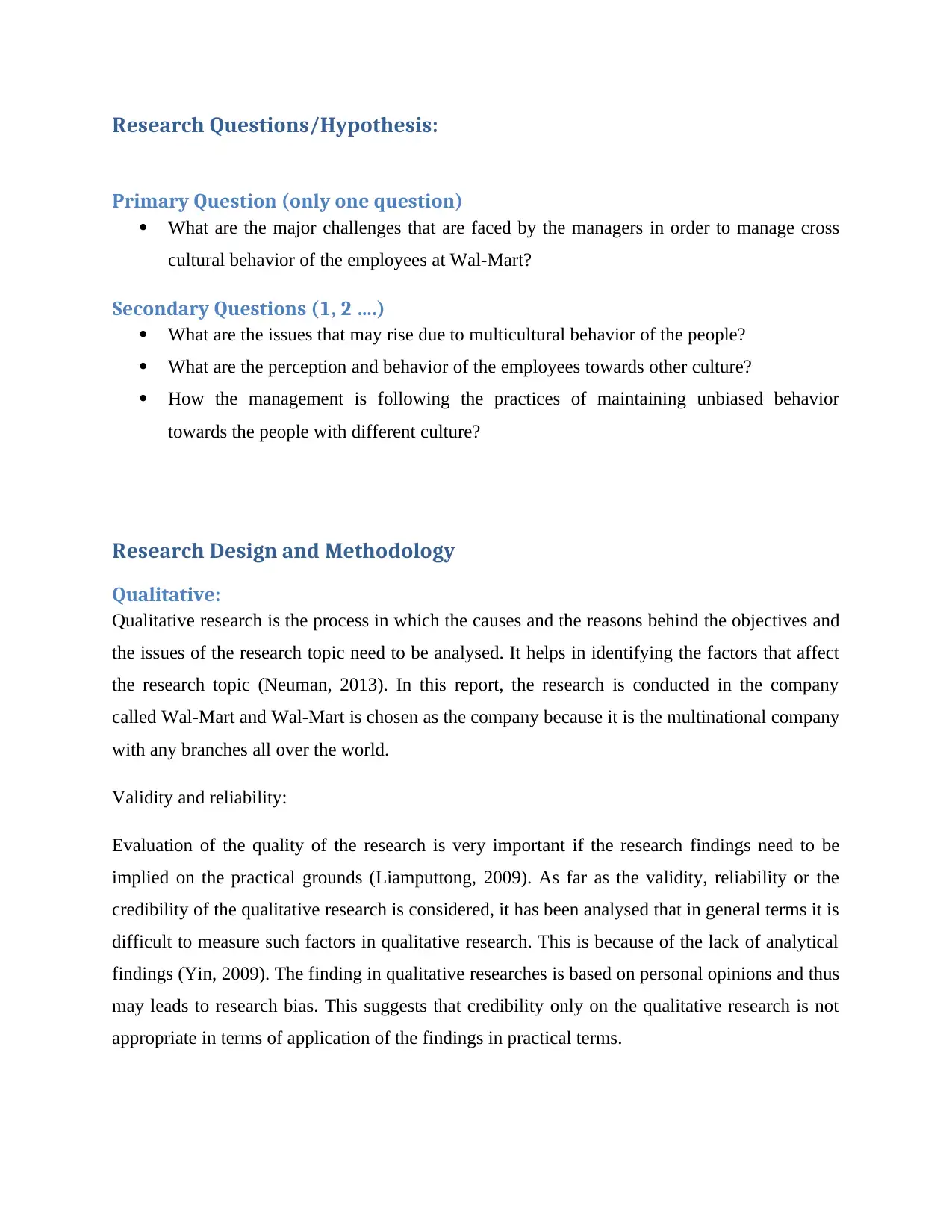
Research Questions/Hypothesis:
Primary Question (only one question)
What are the major challenges that are faced by the managers in order to manage cross
cultural behavior of the employees at Wal-Mart?
Secondary Questions (1, 2 ….)
What are the issues that may rise due to multicultural behavior of the people?
What are the perception and behavior of the employees towards other culture?
How the management is following the practices of maintaining unbiased behavior
towards the people with different culture?
Research Design and Methodology
Qualitative:
Qualitative research is the process in which the causes and the reasons behind the objectives and
the issues of the research topic need to be analysed. It helps in identifying the factors that affect
the research topic (Neuman, 2013). In this report, the research is conducted in the company
called Wal-Mart and Wal-Mart is chosen as the company because it is the multinational company
with any branches all over the world.
Validity and reliability:
Evaluation of the quality of the research is very important if the research findings need to be
implied on the practical grounds (Liamputtong, 2009). As far as the validity, reliability or the
credibility of the qualitative research is considered, it has been analysed that in general terms it is
difficult to measure such factors in qualitative research. This is because of the lack of analytical
findings (Yin, 2009). The finding in qualitative researches is based on personal opinions and thus
may leads to research bias. This suggests that credibility only on the qualitative research is not
appropriate in terms of application of the findings in practical terms.
Primary Question (only one question)
What are the major challenges that are faced by the managers in order to manage cross
cultural behavior of the employees at Wal-Mart?
Secondary Questions (1, 2 ….)
What are the issues that may rise due to multicultural behavior of the people?
What are the perception and behavior of the employees towards other culture?
How the management is following the practices of maintaining unbiased behavior
towards the people with different culture?
Research Design and Methodology
Qualitative:
Qualitative research is the process in which the causes and the reasons behind the objectives and
the issues of the research topic need to be analysed. It helps in identifying the factors that affect
the research topic (Neuman, 2013). In this report, the research is conducted in the company
called Wal-Mart and Wal-Mart is chosen as the company because it is the multinational company
with any branches all over the world.
Validity and reliability:
Evaluation of the quality of the research is very important if the research findings need to be
implied on the practical grounds (Liamputtong, 2009). As far as the validity, reliability or the
credibility of the qualitative research is considered, it has been analysed that in general terms it is
difficult to measure such factors in qualitative research. This is because of the lack of analytical
findings (Yin, 2009). The finding in qualitative researches is based on personal opinions and thus
may leads to research bias. This suggests that credibility only on the qualitative research is not
appropriate in terms of application of the findings in practical terms.
⊘ This is a preview!⊘
Do you want full access?
Subscribe today to unlock all pages.

Trusted by 1+ million students worldwide
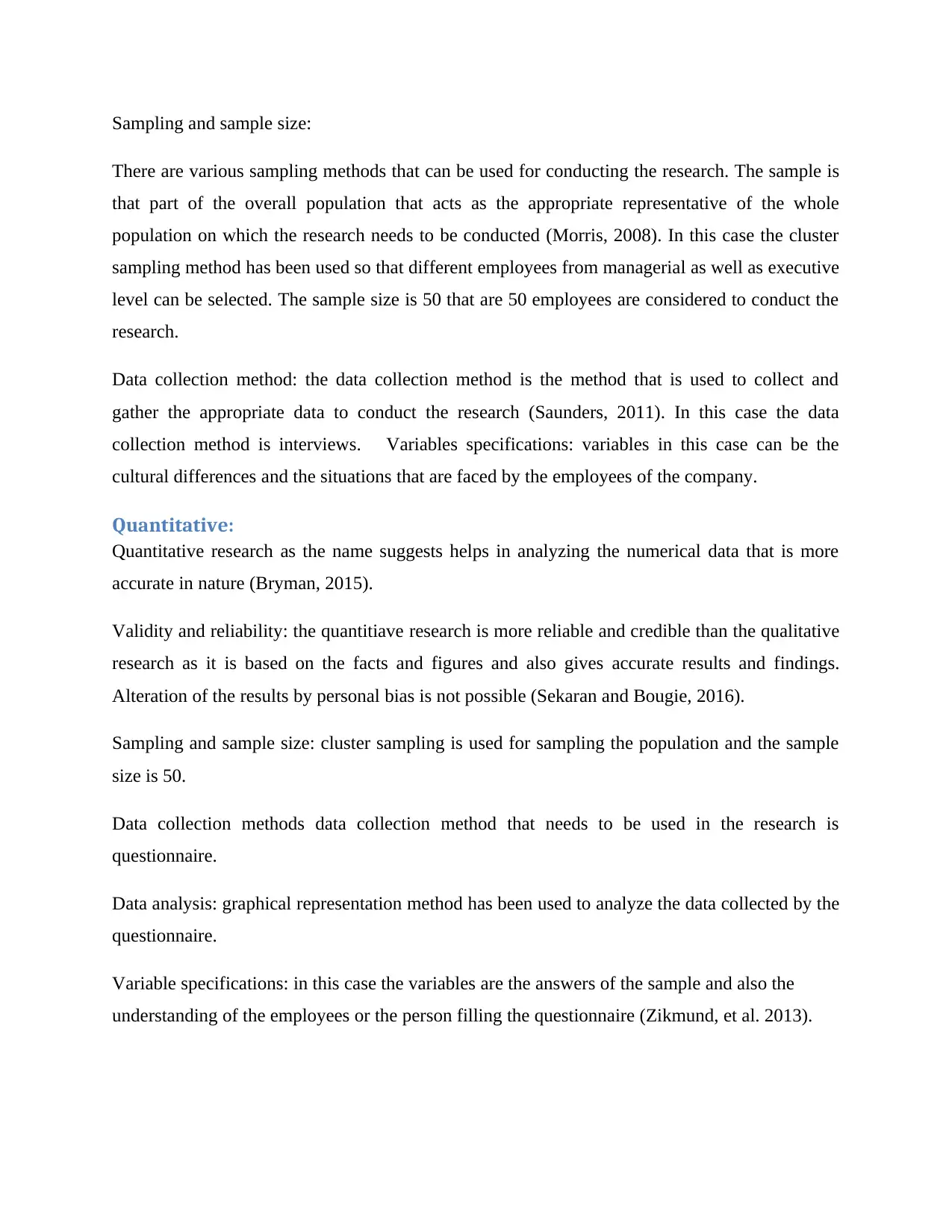
Sampling and sample size:
There are various sampling methods that can be used for conducting the research. The sample is
that part of the overall population that acts as the appropriate representative of the whole
population on which the research needs to be conducted (Morris, 2008). In this case the cluster
sampling method has been used so that different employees from managerial as well as executive
level can be selected. The sample size is 50 that are 50 employees are considered to conduct the
research.
Data collection method: the data collection method is the method that is used to collect and
gather the appropriate data to conduct the research (Saunders, 2011). In this case the data
collection method is interviews. Variables specifications: variables in this case can be the
cultural differences and the situations that are faced by the employees of the company.
Quantitative:
Quantitative research as the name suggests helps in analyzing the numerical data that is more
accurate in nature (Bryman, 2015).
Validity and reliability: the quantitiave research is more reliable and credible than the qualitative
research as it is based on the facts and figures and also gives accurate results and findings.
Alteration of the results by personal bias is not possible (Sekaran and Bougie, 2016).
Sampling and sample size: cluster sampling is used for sampling the population and the sample
size is 50.
Data collection methods data collection method that needs to be used in the research is
questionnaire.
Data analysis: graphical representation method has been used to analyze the data collected by the
questionnaire.
Variable specifications: in this case the variables are the answers of the sample and also the
understanding of the employees or the person filling the questionnaire (Zikmund, et al. 2013).
There are various sampling methods that can be used for conducting the research. The sample is
that part of the overall population that acts as the appropriate representative of the whole
population on which the research needs to be conducted (Morris, 2008). In this case the cluster
sampling method has been used so that different employees from managerial as well as executive
level can be selected. The sample size is 50 that are 50 employees are considered to conduct the
research.
Data collection method: the data collection method is the method that is used to collect and
gather the appropriate data to conduct the research (Saunders, 2011). In this case the data
collection method is interviews. Variables specifications: variables in this case can be the
cultural differences and the situations that are faced by the employees of the company.
Quantitative:
Quantitative research as the name suggests helps in analyzing the numerical data that is more
accurate in nature (Bryman, 2015).
Validity and reliability: the quantitiave research is more reliable and credible than the qualitative
research as it is based on the facts and figures and also gives accurate results and findings.
Alteration of the results by personal bias is not possible (Sekaran and Bougie, 2016).
Sampling and sample size: cluster sampling is used for sampling the population and the sample
size is 50.
Data collection methods data collection method that needs to be used in the research is
questionnaire.
Data analysis: graphical representation method has been used to analyze the data collected by the
questionnaire.
Variable specifications: in this case the variables are the answers of the sample and also the
understanding of the employees or the person filling the questionnaire (Zikmund, et al. 2013).
Paraphrase This Document
Need a fresh take? Get an instant paraphrase of this document with our AI Paraphraser
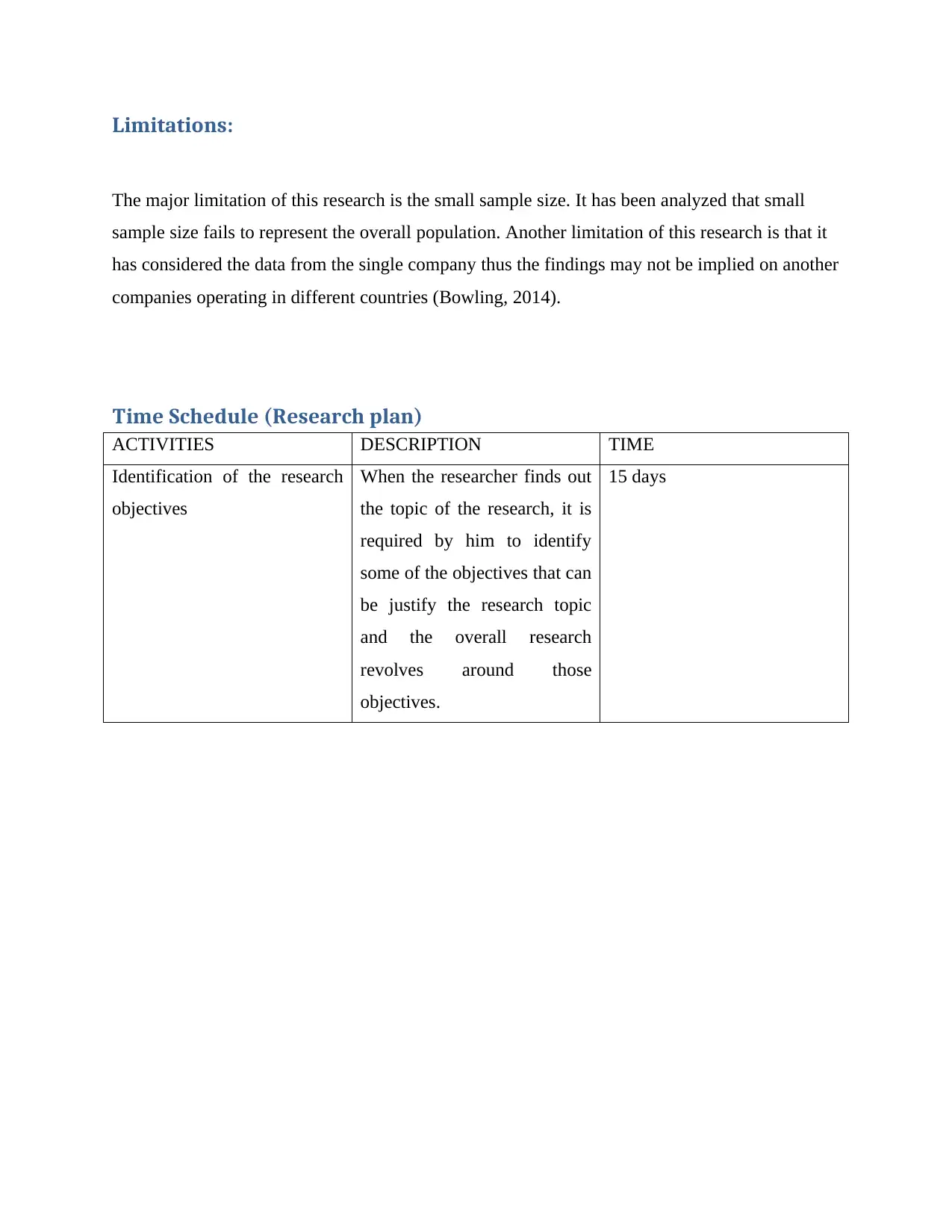
Limitations:
The major limitation of this research is the small sample size. It has been analyzed that small
sample size fails to represent the overall population. Another limitation of this research is that it
has considered the data from the single company thus the findings may not be implied on another
companies operating in different countries (Bowling, 2014).
Time Schedule (Research plan)
ACTIVITIES DESCRIPTION TIME
Identification of the research
objectives
When the researcher finds out
the topic of the research, it is
required by him to identify
some of the objectives that can
be justify the research topic
and the overall research
revolves around those
objectives.
15 days
The major limitation of this research is the small sample size. It has been analyzed that small
sample size fails to represent the overall population. Another limitation of this research is that it
has considered the data from the single company thus the findings may not be implied on another
companies operating in different countries (Bowling, 2014).
Time Schedule (Research plan)
ACTIVITIES DESCRIPTION TIME
Identification of the research
objectives
When the researcher finds out
the topic of the research, it is
required by him to identify
some of the objectives that can
be justify the research topic
and the overall research
revolves around those
objectives.
15 days
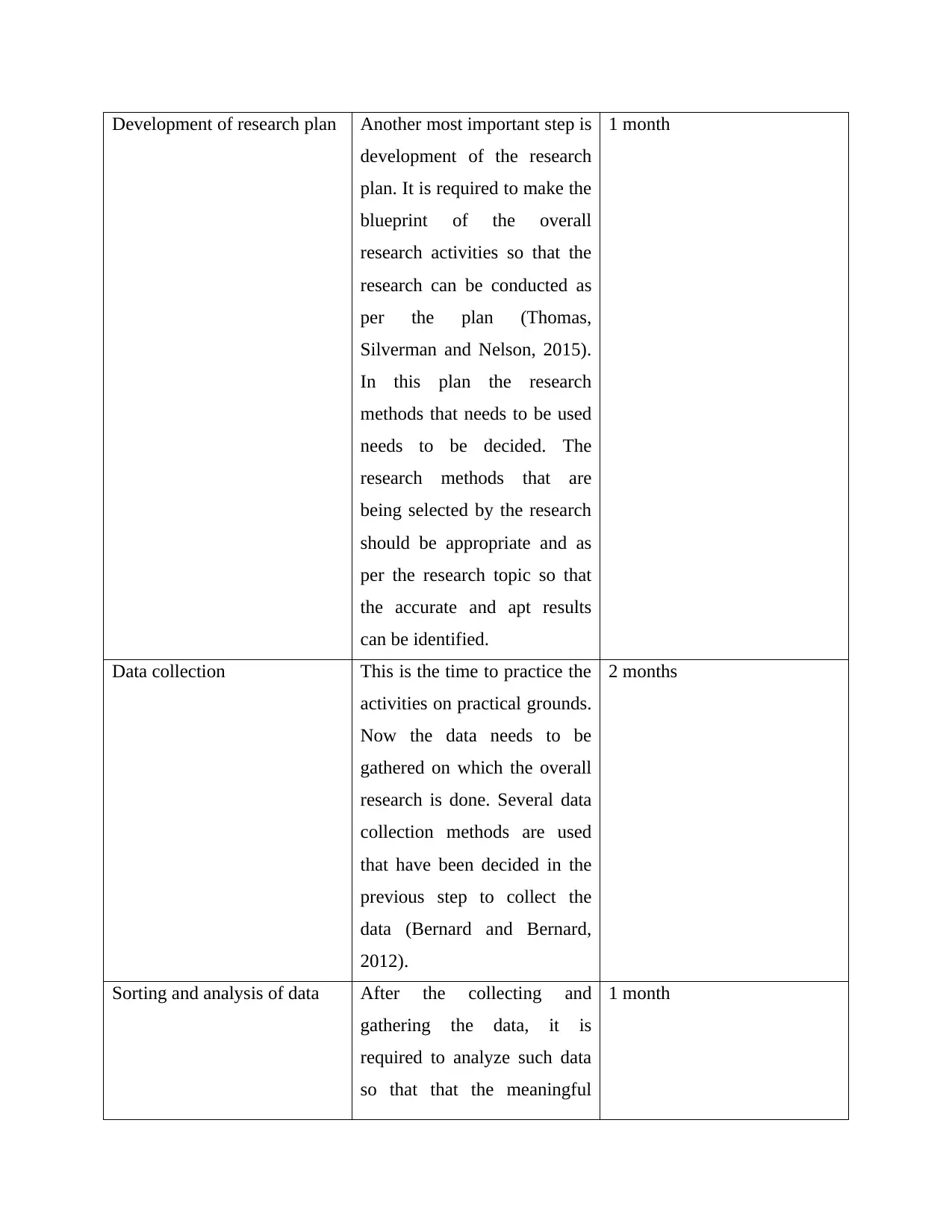
Development of research plan Another most important step is
development of the research
plan. It is required to make the
blueprint of the overall
research activities so that the
research can be conducted as
per the plan (Thomas,
Silverman and Nelson, 2015).
In this plan the research
methods that needs to be used
needs to be decided. The
research methods that are
being selected by the research
should be appropriate and as
per the research topic so that
the accurate and apt results
can be identified.
1 month
Data collection This is the time to practice the
activities on practical grounds.
Now the data needs to be
gathered on which the overall
research is done. Several data
collection methods are used
that have been decided in the
previous step to collect the
data (Bernard and Bernard,
2012).
2 months
Sorting and analysis of data After the collecting and
gathering the data, it is
required to analyze such data
so that that the meaningful
1 month
development of the research
plan. It is required to make the
blueprint of the overall
research activities so that the
research can be conducted as
per the plan (Thomas,
Silverman and Nelson, 2015).
In this plan the research
methods that needs to be used
needs to be decided. The
research methods that are
being selected by the research
should be appropriate and as
per the research topic so that
the accurate and apt results
can be identified.
1 month
Data collection This is the time to practice the
activities on practical grounds.
Now the data needs to be
gathered on which the overall
research is done. Several data
collection methods are used
that have been decided in the
previous step to collect the
data (Bernard and Bernard,
2012).
2 months
Sorting and analysis of data After the collecting and
gathering the data, it is
required to analyze such data
so that that the meaningful
1 month
⊘ This is a preview!⊘
Do you want full access?
Subscribe today to unlock all pages.

Trusted by 1+ million students worldwide
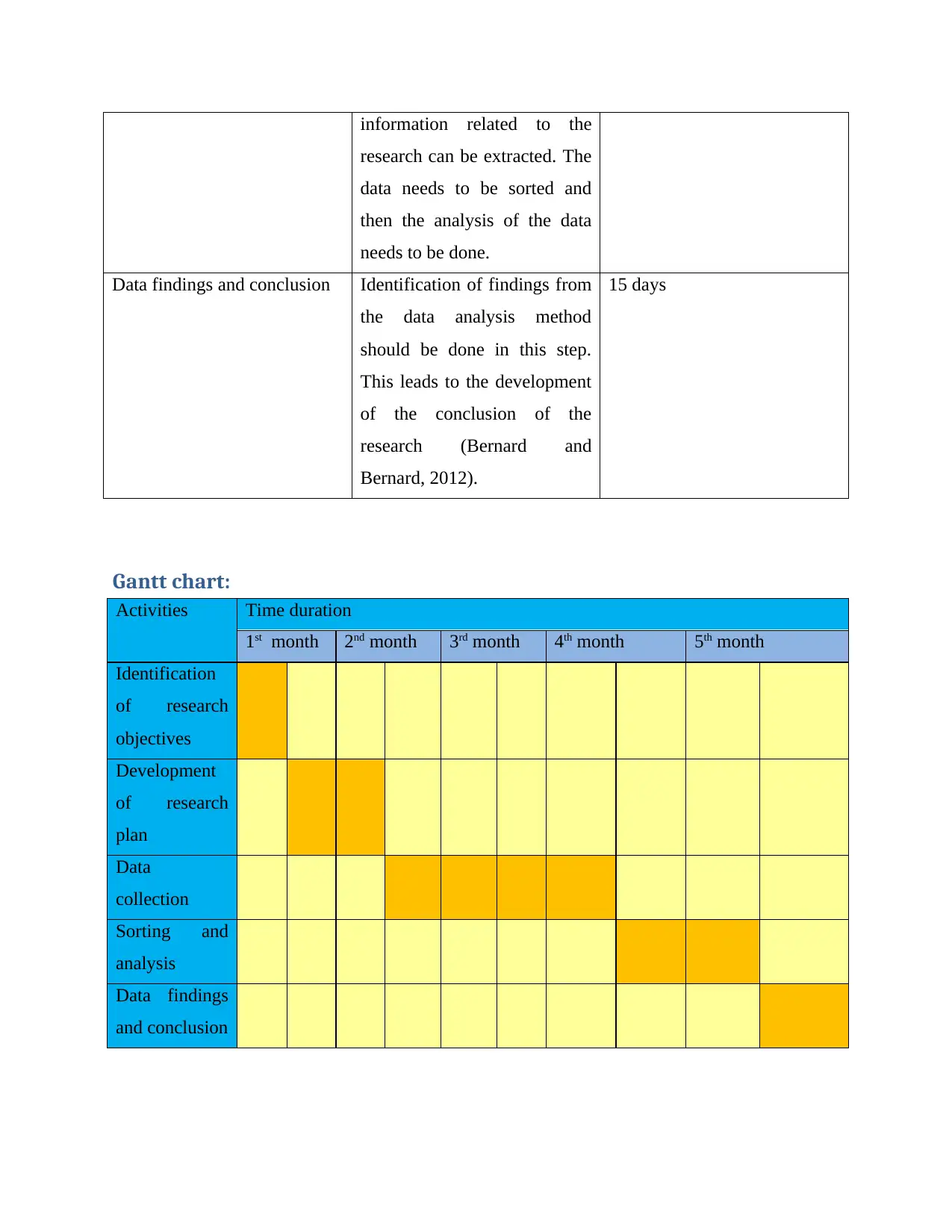
information related to the
research can be extracted. The
data needs to be sorted and
then the analysis of the data
needs to be done.
Data findings and conclusion Identification of findings from
the data analysis method
should be done in this step.
This leads to the development
of the conclusion of the
research (Bernard and
Bernard, 2012).
15 days
Gantt chart:
Activities Time duration
1st month 2nd month 3rd month 4th month 5th month
Identification
of research
objectives
Development
of research
plan
Data
collection
Sorting and
analysis
Data findings
and conclusion
research can be extracted. The
data needs to be sorted and
then the analysis of the data
needs to be done.
Data findings and conclusion Identification of findings from
the data analysis method
should be done in this step.
This leads to the development
of the conclusion of the
research (Bernard and
Bernard, 2012).
15 days
Gantt chart:
Activities Time duration
1st month 2nd month 3rd month 4th month 5th month
Identification
of research
objectives
Development
of research
plan
Data
collection
Sorting and
analysis
Data findings
and conclusion
Paraphrase This Document
Need a fresh take? Get an instant paraphrase of this document with our AI Paraphraser
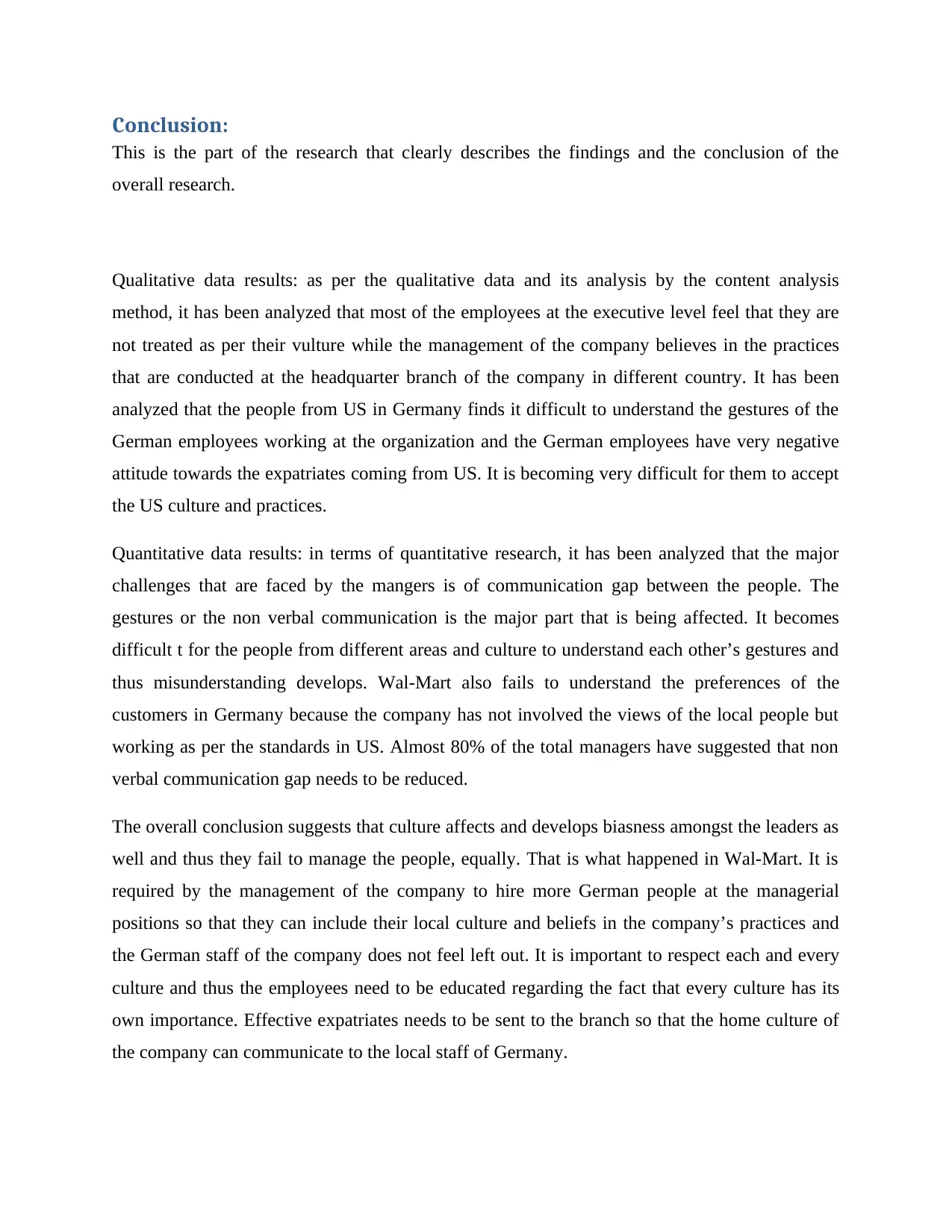
Conclusion:
This is the part of the research that clearly describes the findings and the conclusion of the
overall research.
Qualitative data results: as per the qualitative data and its analysis by the content analysis
method, it has been analyzed that most of the employees at the executive level feel that they are
not treated as per their vulture while the management of the company believes in the practices
that are conducted at the headquarter branch of the company in different country. It has been
analyzed that the people from US in Germany finds it difficult to understand the gestures of the
German employees working at the organization and the German employees have very negative
attitude towards the expatriates coming from US. It is becoming very difficult for them to accept
the US culture and practices.
Quantitative data results: in terms of quantitative research, it has been analyzed that the major
challenges that are faced by the mangers is of communication gap between the people. The
gestures or the non verbal communication is the major part that is being affected. It becomes
difficult t for the people from different areas and culture to understand each other’s gestures and
thus misunderstanding develops. Wal-Mart also fails to understand the preferences of the
customers in Germany because the company has not involved the views of the local people but
working as per the standards in US. Almost 80% of the total managers have suggested that non
verbal communication gap needs to be reduced.
The overall conclusion suggests that culture affects and develops biasness amongst the leaders as
well and thus they fail to manage the people, equally. That is what happened in Wal-Mart. It is
required by the management of the company to hire more German people at the managerial
positions so that they can include their local culture and beliefs in the company’s practices and
the German staff of the company does not feel left out. It is important to respect each and every
culture and thus the employees need to be educated regarding the fact that every culture has its
own importance. Effective expatriates needs to be sent to the branch so that the home culture of
the company can communicate to the local staff of Germany.
This is the part of the research that clearly describes the findings and the conclusion of the
overall research.
Qualitative data results: as per the qualitative data and its analysis by the content analysis
method, it has been analyzed that most of the employees at the executive level feel that they are
not treated as per their vulture while the management of the company believes in the practices
that are conducted at the headquarter branch of the company in different country. It has been
analyzed that the people from US in Germany finds it difficult to understand the gestures of the
German employees working at the organization and the German employees have very negative
attitude towards the expatriates coming from US. It is becoming very difficult for them to accept
the US culture and practices.
Quantitative data results: in terms of quantitative research, it has been analyzed that the major
challenges that are faced by the mangers is of communication gap between the people. The
gestures or the non verbal communication is the major part that is being affected. It becomes
difficult t for the people from different areas and culture to understand each other’s gestures and
thus misunderstanding develops. Wal-Mart also fails to understand the preferences of the
customers in Germany because the company has not involved the views of the local people but
working as per the standards in US. Almost 80% of the total managers have suggested that non
verbal communication gap needs to be reduced.
The overall conclusion suggests that culture affects and develops biasness amongst the leaders as
well and thus they fail to manage the people, equally. That is what happened in Wal-Mart. It is
required by the management of the company to hire more German people at the managerial
positions so that they can include their local culture and beliefs in the company’s practices and
the German staff of the company does not feel left out. It is important to respect each and every
culture and thus the employees need to be educated regarding the fact that every culture has its
own importance. Effective expatriates needs to be sent to the branch so that the home culture of
the company can communicate to the local staff of Germany.
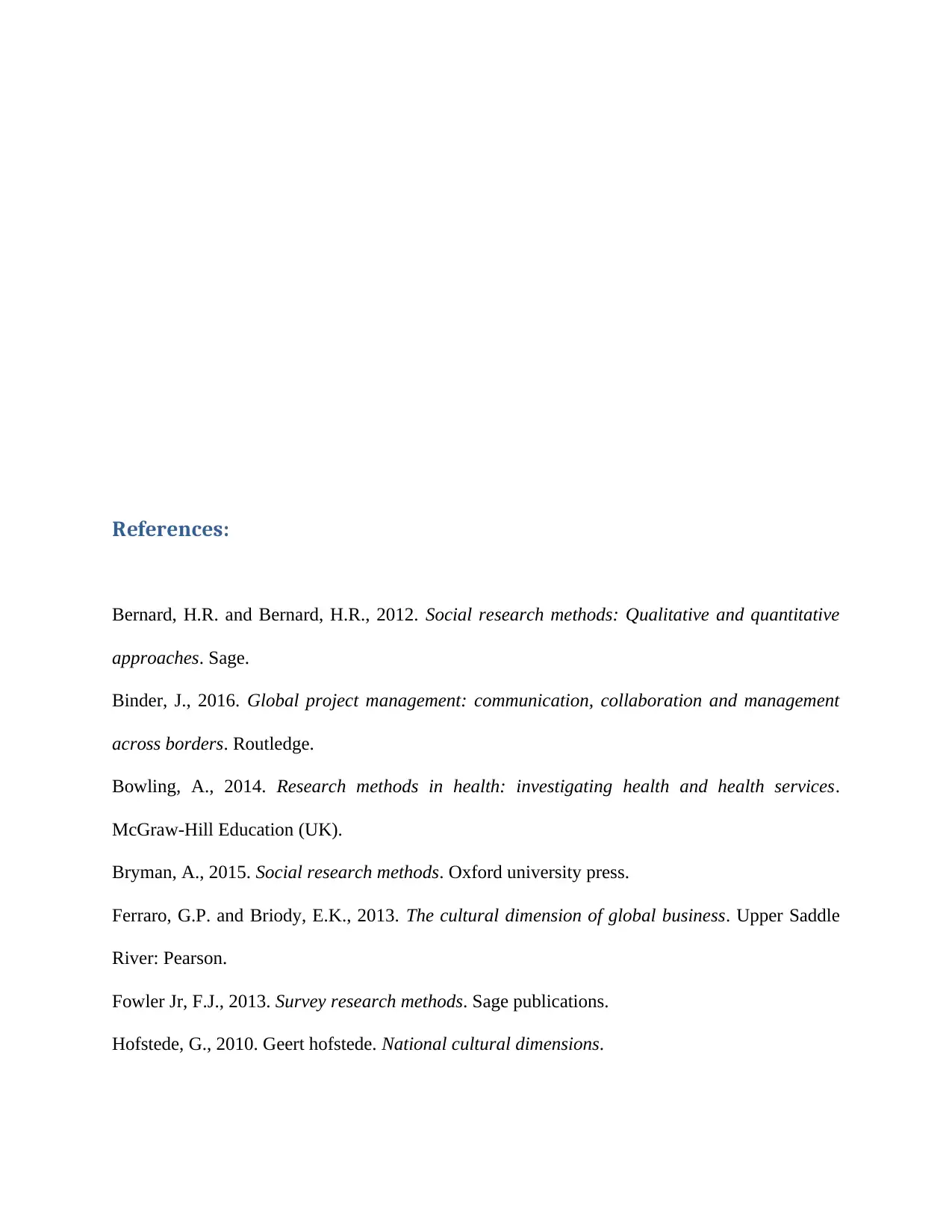
References:
Bernard, H.R. and Bernard, H.R., 2012. Social research methods: Qualitative and quantitative
approaches. Sage.
Binder, J., 2016. Global project management: communication, collaboration and management
across borders. Routledge.
Bowling, A., 2014. Research methods in health: investigating health and health services.
McGraw-Hill Education (UK).
Bryman, A., 2015. Social research methods. Oxford university press.
Ferraro, G.P. and Briody, E.K., 2013. The cultural dimension of global business. Upper Saddle
River: Pearson.
Fowler Jr, F.J., 2013. Survey research methods. Sage publications.
Hofstede, G., 2010. Geert hofstede. National cultural dimensions.
Bernard, H.R. and Bernard, H.R., 2012. Social research methods: Qualitative and quantitative
approaches. Sage.
Binder, J., 2016. Global project management: communication, collaboration and management
across borders. Routledge.
Bowling, A., 2014. Research methods in health: investigating health and health services.
McGraw-Hill Education (UK).
Bryman, A., 2015. Social research methods. Oxford university press.
Ferraro, G.P. and Briody, E.K., 2013. The cultural dimension of global business. Upper Saddle
River: Pearson.
Fowler Jr, F.J., 2013. Survey research methods. Sage publications.
Hofstede, G., 2010. Geert hofstede. National cultural dimensions.
⊘ This is a preview!⊘
Do you want full access?
Subscribe today to unlock all pages.

Trusted by 1+ million students worldwide
1 out of 15
Related Documents
Your All-in-One AI-Powered Toolkit for Academic Success.
+13062052269
info@desklib.com
Available 24*7 on WhatsApp / Email
![[object Object]](/_next/static/media/star-bottom.7253800d.svg)
Unlock your academic potential
Copyright © 2020–2025 A2Z Services. All Rights Reserved. Developed and managed by ZUCOL.





